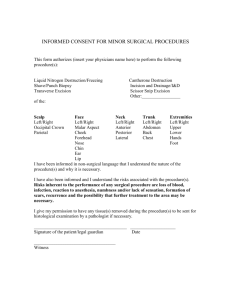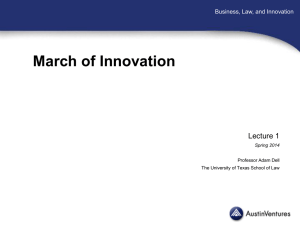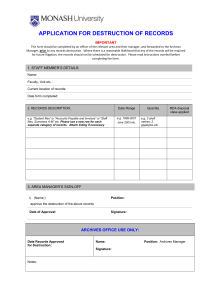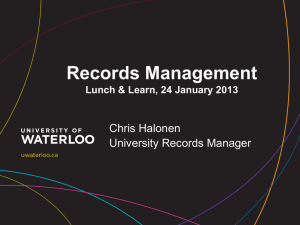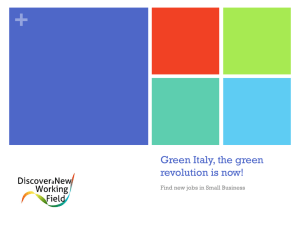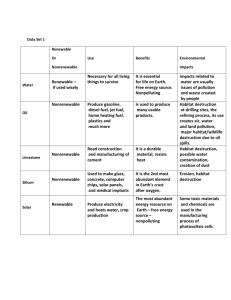DuPont Chemicals and Fluoroproducts
advertisement
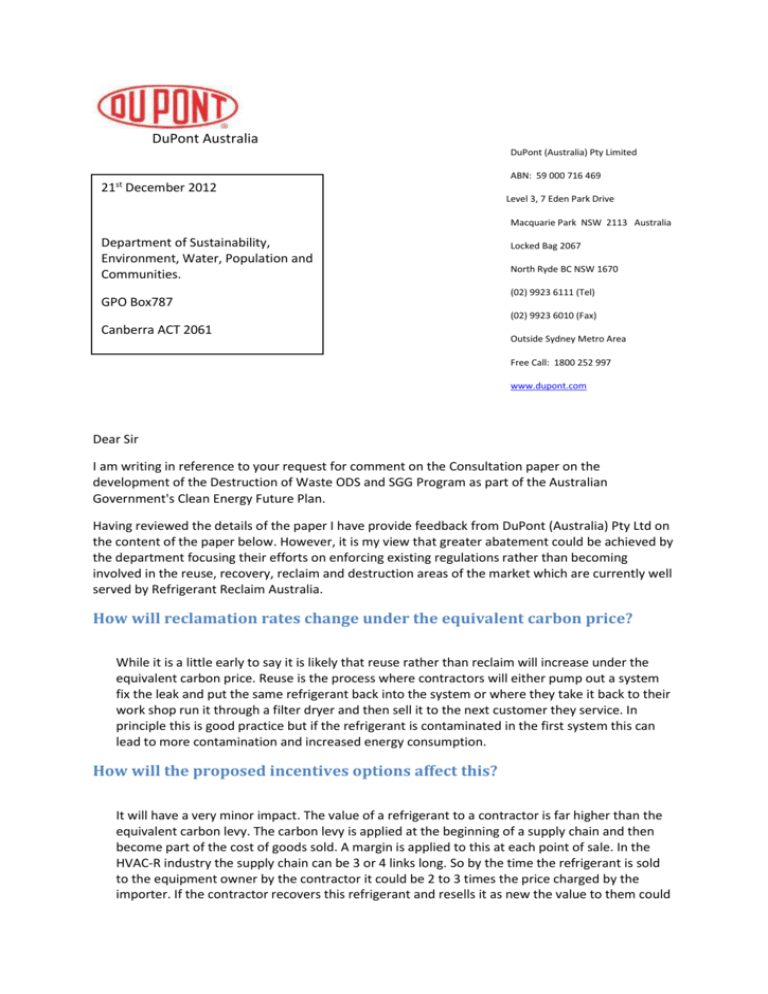
DuPont Australia DuPont (Australia) Pty Limited 21st December 2012 ABN: 59 000 716 469 Level 3, 7 Eden Park Drive Macquarie Park NSW 2113 Australia Department of Sustainability, Environment, Water, Population and Communities. GPO Box787 Locked Bag 2067 North Ryde BC NSW 1670 (02) 9923 6111 (Tel) (02) 9923 6010 (Fax) Canberra ACT 2061 Outside Sydney Metro Area Free Call: 1800 252 997 www.dupont.com Dear Sir I am writing in reference to your request for comment on the Consultation paper on the development of the Destruction of Waste ODS and SGG Program as part of the Australian Government's Clean Energy Future Plan. Having reviewed the details of the paper I have provide feedback from DuPont (Australia) Pty Ltd on the content of the paper below. However, it is my view that greater abatement could be achieved by the department focusing their efforts on enforcing existing regulations rather than becoming involved in the reuse, recovery, reclaim and destruction areas of the market which are currently well served by Refrigerant Reclaim Australia. How will reclamation rates change under the equivalent carbon price? While it is a little early to say it is likely that reuse rather than reclaim will increase under the equivalent carbon price. Reuse is the process where contractors will either pump out a system fix the leak and put the same refrigerant back into the system or where they take it back to their work shop run it through a filter dryer and then sell it to the next customer they service. In principle this is good practice but if the refrigerant is contaminated in the first system this can lead to more contamination and increased energy consumption. How will the proposed incentives options affect this? It will have a very minor impact. The value of a refrigerant to a contractor is far higher than the equivalent carbon levy. The carbon levy is applied at the beginning of a supply chain and then become part of the cost of goods sold. A margin is applied to this at each point of sale. In the HVAC-R industry the supply chain can be 3 or 4 links long. So by the time the refrigerant is sold to the equipment owner by the contractor it could be 2 to 3 times the price charged by the importer. If the contractor recovers this refrigerant and resells it as new the value to them could be 4 or 5 times that of the carbon levy. So unless the incentive is 4 or 5 times the size of the levy it will never match the value of the refrigerant to the contractor. Only unusable and badly contaminated refrigerant will be returned for either reclamation or destruction. What level of destruction incentive could promote recovery from fire extinguishers, insulation foams, vehicles and domestic or small commercial refrigerators and air conditioning units? The value of the Extinguishing agent to the contractor is now such that this will be recovered and reused in the same way refrigerant will be. The advantage in this industry is that there is less chance of contamination as the systems are clearly labeled. The incentive will have no effect of insulation foam recovery as the cost far out w ay the value of the recovered agent due to the small volume of expansion agent needed to produce foam. There may be a small increase in recovery from wrecked motor vehicles. But a major cause of write off of vehicles come from front end collisions which usually results in the loss of the refrigerant charge. The cost of recovery from domestic appliances will far outweigh the incentive as in the insulating form case. Recovery will only increase from foam and domestic appliances if a properly instigate product stewardship scheme is enacted for fridge freezers as in the EU and Japan. Improve recovery from small commercial refrigeration and Air conditioning will only be driven by a properly instigated product stewardship scheme and greater enforcement of the current legislation. What is the likely need for HCFC destruction over the coming years? There is likely to be a short term shortage of HCFC’s in the next 3-5 years as the phase out starts to bite. However equipment containing HCFC’s is being retired as it reaches the end of its useful life. The demand for HCFC’s particularly R22 for service will continue to decline sharply. There are now HFC’s retrofit options available to equipment with a longer working life and these are now cheaper than R22. So there will be limited recycling of R22 for the next 3 – 5 years but then there will be no demand for the R22 and the majority of the 12,000 MT in the banks will either escape or need destroying. What requirements should an accredited destruction provider meet? While there is merit to allow specialized recovery providers in certain market segments and program needs to be national. So if a destruction provider is appointed for the supermarket area for instance it needs to be a national provider. The provider should have to demonstrate capability and record recoveries from states and regional areas. The provider should be able to provide details of what has been destroyed which requires mandatory testing. The destruction provider should be able to provide a detailed audit trail and complete financial records of where government funds are spent. The provider should be able to demonstrate capabilities to meet all national and state regulatory controls. Should destruction providers have broad coverage or should they be able to provide targeted services? Targeted services should be allowable as long as they are national. Otherwise providers will set up in capital cities and regional Australia will be ignored due to the cost. What requirements should an accredited destruction facility meet? Approved standards for a destruction facility are set out by the united nations. These should be the minimum standards Is it feasible to identify the species of gases presented to accredited destruction facilities before incentive payments are made? Yes this is currently done now by RRA and should be a mandatory requirement to prove the accuracy of the system. Who should be able to claim incentive payments from destruction providers and what conditions should they be required to meet? To be able to claim incentive payments from the provider the claimant should have to provide proof of ownership of and have an appropriate ARC license. For larger volume they should have to provide details of where the product has come from. What is the quantity of high GWP SGGs that will likely be sent for destruction? The amount of high GWP product returned for destruction will be low due to the replacement cost and value to the equipment owner and/or contractor. Equipment owners will insist on their existing product being reused. Contractors will reuse product from decommissioned plant based on its value to them and replacement costs. Should high GWP gases be included in the destruction program? If this is environmental policy they have to be as these are the products that do the most damage. If high GWP gases are included in the destruction program, what incentive should they receive and should there be restrictions on who can claim incentives? It should be done on the same basis as all other products. If it is environmental policy the incentive to prevent the release of these products should be commensurate with the environmental damage caused by their release. Again these products will be less likely to be released than lower GWP refrigerants due to their replacement value and value to the equipment owner and contractor Are there any other manufacturing or business models that would destroy SGGs or ODS through their use or manufacture? R123 is used in a pharmaceutical application as a feed stock and is consumed in the process. Since HCFC’s do not attract the carbon equivalent price it is not affected by this legislation. Where SGG’s are consumed in an industrial process the user should be able to provide details of the destruction method and then claim the destruction incentive What factors should influence decision making about whether to fund destruction for these purposes and the method for funding the destruction in such examples? In some processes such as explosion bags it is impossible to measure the destruction but the chemical process for the destruction and temperatures achieved at the point of the explosion are well known. This should be enough to demonstrate that destruction occurs. Details of any chemical destruction process could be assessed by the CSIRO. Would a flat rate incentive payment provide a workable program for industry? Yes, clearly this is how the industry has been running the program for many years. If a GWP based flat rate was implemented, which calculation would industry prefer: o the average of the gas species and volume of ODS and SGGs sent for destruction during the past year This is the best method available as it will follow movement of various GWP products through the bank. As low GWP products are introduced in the future and then reach the end of their life and are recovered the incentive will fall with the less environmentally damaging products reach the end of life. o the gas species and volume in the Australian bank of equipment This is not accurately known so should not be used. o the gas species and volume imported to Australia in the previous year While this may work now it will not work in the future as low GWP products are introduced to the market while the higher GWP products are recovered and destroyed. So this method should not be used. Are there any other ways to calculate a flat rate incentive payment? Not that I can think of. To what extent would it be practical and cost effective for destruction providers to measure the composition of gases surrendered to them? It is currently done now by RRA and should be a mandatory requirement for claiming the incentive payment What technology options are available to do this and what are the costs? There are accurate gas analyzers on the market currently but the best method uses a gas chromatogram. While these require a skilled technician they are not that expensive and the tests are not that expensive to run Where gas composition measurement is practical and cost effective would the benefits of GWP-based rebates flow through the supply chain and to whom? This is a commercial matter for the destruction provider. If the goal of this change is to promote competition and efficiency in the collection reuse, recycling and destruction of ODS and SGG the department can not involve itself in the commercial activity of the destruction provider. To do so and set criteria around incentive payments etc. would defeat the purpose of promoting competition. However, it would be possible that there would be a hybrid program. Most of the product currently returned for destruction is collected in small quantities from multiple jobs by a contractor and returned to a wholesaler for return to RRA. In this case this material could be paid at a flat rate as is the current practice. However where equipment is being retired for example from a supermarket and the volume is substantial the equipment owner and contractor may prefer to send this material back for analysis and destruction and receive a GWP based payment. The criteria to allow this to happen would need to be set by the destruction provider and be based on their cost structure and capability. This would be part of the competitive nature of the market and allow equipment owners to recover costs which they currently are unable to do. It may also promote recovery from end of life equipment as the current program does not provide an incentive to the equipment owner where this type of program could. Where gas composition measurement is not practical, how would destruction providers structure the incentives paid to the supply chain? For example, would they be based on average GWP or a lower rate? Again this is a commercial matter for the destruction provider. They will have to provide an incentive that is competitive to ensure they receive material back from the market. How would industry manage the flexible prices of a GWP-based model after 2015? This is a major unknown for the industry. If the incentive is based on the carbon price and that prices is too low to cover the cost of the recovery the program will stop. Given the emission has been paid for at the point of import this become a commercial issue for the industry as it is with any other entity captured under the Clean energy future legislation. If the cost more to achieve the abatement than it does to pay for the emission then the emission will occur. This is the point of a market based system. Would the hybrid model be a workable program for industry? Yes this could work and would help secure the program against a low market based carbon price while allowing the destruction provider to provide increased incentive to recover higher GWP products at the end of life. I am grateful for the opportunity to provide input into this important program and hope that after this consultation the department will be able to develop a program that will provide the desired outcome in an effective manner as Refrigerant Reclaim Australia has been able to do for many years at no cost to the tax payer Yours sincerely John McCormack Business Manager DuPont Chemicals and Fluoroproducts
